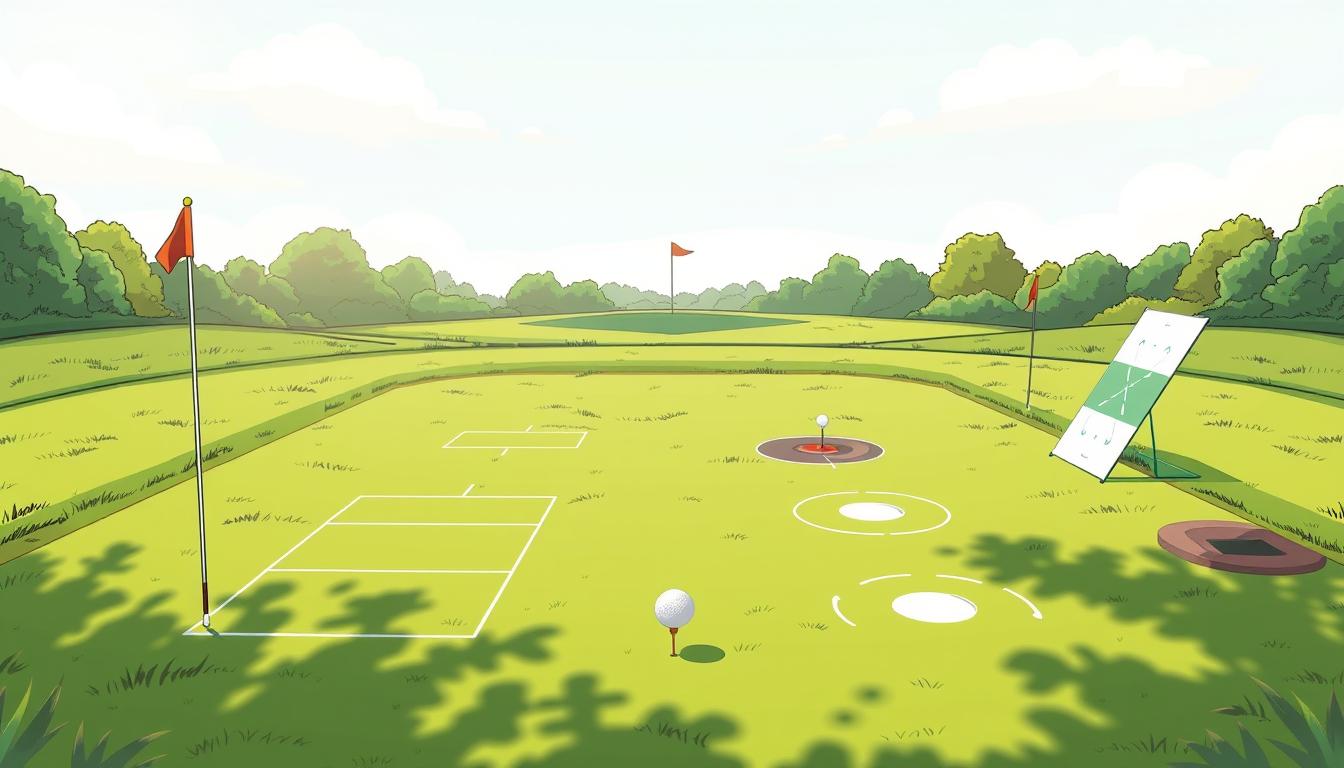Golf putting drills are key to bettering your game. Since about 40% of golf is played on the green, mastering putting is crucial. This guide shares top drills to enhance your accuracy and confidence on the green.
Good putting means rolling putts right, having a smooth stroke, and controlling speed. Focus on these to improve your putting skills.
Regular practice with these drills will help you get a feel for the greens. Remember, putting is as much about mental game as physical technique. As you practice, you’ll gain the confidence to perform well under pressure.
Key Takeaways
- Putting accounts for about 40% of a golf game
- Focus on stroke technique, speed control, and sinking putts
- Use a putting mirror to improve alignment and stance
- Practice straight-back, straight-through and arc putting strokes
- Incorporate drills like the manila folder and clock drill for better speed control
- Use one-handed putting drills to enhance precision and alignment
- Consistent practice leads to improved performance and lower scores
Essential Fundamentals of Putting Stroke Mechanics
Learning the right putting stroke techniques is key to better golf scores. A consistent stroke can turn a good game into an excellent one. Let’s look at the main parts of a smooth putting stroke.
Understanding Proper Eye Alignment
Eye alignment is crucial for accurate putting. Use a string between two cups to create a straight line from the ball to the target. This helps you keep your eyes over the ball, leading to a consistent stroke.
Grip and Stance Fundamentals
Your grip and stance are the base of a smooth stroke. Pick a putter that fits your natural stroke, whether it’s a blade or mallet. Try different lengths, from 28 to 35 inches for standard putters. A light grip helps you control and feel the putter better.
Putter Face Alignment Techniques
Aligning the putter face correctly is key for direction. Use alignment sticks or a putting mirror to square the face to your target line. This ensures the face is flat at address, leading to a more consistent stroke.
| Factor | Influence on Putt Direction |
|---|---|
| Club Face Angle | 98% |
| Swing Path | 2% |
The club face greatly affects the ball’s direction, more than the swing path. Keep your body steady and wrists firm during follow-through for the best contact. With practice, these basics will help you achieve a reliable and smooth stroke.
Mastering the Mirror Practice Technique
Putting mirror practice is a game-changer for golfers. It helps you perfect your stroke with immediate visual feedback. You can work on alignment, stance, and ball position without an instructor.
Setting Up Your Putting Mirror
The Pro Path Putting Mirror is a favorite among golfers, including pros like Cam Smith. It works for both left and right-handed players. Place the mirror on your practice surface and align it with your target line.
This setup lets you check your eye position over the ball and shoulder alignment. It’s a great way to practice.
Alignment Rod Integration
Adding alignment rods to your mirror practice gives you more feedback. Place rods along the mirror’s edges. This helps you practice a straight-back and straight-through stroke.
It also lets you see your stroke path and keep your putter face square at impact.
Self-Assessment Methods
Self-assessment is key to improving your putting. Use the mirror to check your eye position and shoulder alignment. Spend 15-20 minutes on putting drills to boost your confidence.
For a complete practice routine, try these methods 5-7 times in a row.
| Drill | Purpose | Duration |
|---|---|---|
| Eye Alignment Check | Ensure eyes are directly over the ball | 5 minutes |
| Shoulder Alignment Drill | Parallel shoulders to target line | 5 minutes |
| Stroke Path Practice | Maintain straight back-and-through motion | 10 minutes |
Regular putting mirror practice can greatly improve your short game. It’s an affordable option compared to full swing aids. You can use it at home with an indoor putting green.
Remember, mastering putts inside 6 feet is key to breaking 80 or becoming a scratch golfer.
Straight-Back Straight-Through vs Arc Putting Methods
Golf putting has two main stroke paths: straight-back straight-through and arc putting. Each has its own benefits. Your choice depends on what feels right to you and your natural swing.
The straight-back straight-through method keeps the putter head on a straight line. It’s great for making shorter putts more consistent. Research shows pros keep their wrists still during putting.
Arc putting involves a bit of rotation with the putter head. It might feel more natural for some. But, it needs precise timing to hit the ball square.
| Putting Method | Advantages | Challenges |
|---|---|---|
| Straight-Back Straight-Through | Increased consistency, fewer pulled or pushed putts | May feel unnatural for some golfers |
| Arc Putting | Can feel more natural, allows for body rotation | Requires precise timing for square impact |
To practice straight-back straight-through, use an alignment rod. For arc putting, try a putting arc. Try both to see which fits your game better.
Consistency is crucial in putting. Great putters keep a 2:1 downswing-to-backswing ratio. They swing at 72 to 80 beats per minute. Choose a method and practice it to improve your putting.
Distance Control Training Exercises
Mastering putting distance control is key to lowering your scores. Let’s look at drills to improve your touch on the greens.
The Manila Folder Drill
The manila folder drill helps with distance control. Place a folder 5 feet away. Try to stop three balls on it. As you get better, move the folder back.
This drill teaches you how much force to use for different distances.
Clock Drill Variations
The clock drill is loved by PGA Tour players. Arrange 12 balls in a circle around the hole, like a clock. Putt from each spot, adjusting to different distances.
This drill helps you feel the right amount of force for various lengths and angles.
Progressive Distance Practice
Use markers at 3, 6, 9, and 12 feet from the hole. Place a tee 12-18 inches behind the cup. Aim to stop the ball between the hole and the tee.
This drill sharpens your speed control across different distances.
| Drill | Distance | Goal |
|---|---|---|
| Manila Folder | Start at 5 feet, increase gradually | Stop 3 balls on folder |
| Clock Drill | Varies (circle around hole) | Putt from all angles |
| Progressive | 3, 6, 9, and 12 feet | Stop ball between hole and tee |
Make these drills part of your practice to improve your putting. Remember, regular practice is essential to get better.
One-Handed Putting Drills for Better Control
Learning the one-handed putting drill can really boost your golf game. It’s a method Tiger Woods uses to get a smoother stroke and better control over putts.
The drill is easy but works well. Hold your putter with just your dominant hand. Then, hit 12 putts, keeping your stroke steady and the ball in contact. This drill gives you quick feedback on your putting and helps you feel the putter’s weight.
To make the drill better, set up a gate with two tees. Place them just wider than your putter head on the line you’re aiming for. This helps you hit the ball’s sweet spot and improves your aim.
| Drill Component | Benefit |
|---|---|
| One-handed grip | Improves feel and control |
| 12 repetitions | Builds muscle memory |
| Tee gate | Enhances accuracy and consistency |
Do this drill often, and you’ll see your putting get smoother and more controlled. Remember, putting is about 40% of your game. Getting better at it can really lower your scores.
Rhythm and Tempo Development
Mastering putting rhythm drills is crucial for a better golf game. A smooth, consistent stroke can greatly improve your game on the green. Let’s look at some effective techniques to boost your putting rhythm and tempo.
Metronome Training Methods
Metronome putting is a great way to develop a steady stroke. Use a metronome app on your phone, set it to a comfortable beat. Practice your putts in sync with the rhythm. This builds muscle memory for a consistent tempo.

Pendulum Stroke Practice
The pendulum putting stroke focuses on smooth, even motion. Aim to keep the same speed in both your backswing and forward stroke. This balanced approach leads to more accurate putts and better distance control.
Timing Exercises
Try counting in your head as you putt. Use a simple “1-2” count, with “1” on the backswing and “2” on the forward stroke. This mental timing helps keep a consistent pace throughout your putting motion.
| Drill | Focus | Benefit |
|---|---|---|
| Metronome Putting | Consistent Tempo | Improved Rhythm |
| Pendulum Stroke | Even Motion | Better Accuracy |
| Counting Exercise | Mental Timing | Consistent Pace |
About 40% of your golf game is spent putting. Spending time on these drills can lower your scores a lot. Practice regularly, and you’ll see your putting skills improve.
Advanced Gate Drills for Precision
Putting gate drills are a game-changer for golfers aiming to enhance their precision on the green. These drills challenge your ability to start the ball on the intended line consistently. This is a crucial skill for sinking more putts.
To set up a basic gate drill, place two tees or alignment sticks in the ground. Create a narrow passage for your ball to travel through. Start with a width slightly wider than your putter head and gradually narrow the gate as your skills improve.
Begin your precision putting practice with straight putts from various distances. As you gain confidence, introduce breaking putts to simulate real course conditions. This progression will test your ability to read greens and control your putting stroke under different circumstances.
| Gate Width | Skill Level | Focus Area |
|---|---|---|
| 2 inches | Beginner | Stroke alignment |
| 1.5 inches | Intermediate | Face control |
| 1 inch | Advanced | Precision and consistency |
Remember, the key to mastering putting gate drills is patience and repetition. Start with wider gates and gradually narrow them as your skills improve. This methodical approach will help refine your putting stroke and boost your confidence on the greens.
Speed Control Mastery Techniques
Mastering speed control is key to better putting. Focus on lag putting, breaking putts, and green reading. This will boost your performance on the greens.
Lag Putting Practice
Lag putting is vital for long putts. Try the Phil Mickelson Lag Drill. Putt from 30, 40, and 50 feet, aiming for a three-foot circle around the hole. This drill improves your distance control and lowers three-putt risks.

Breaking Putt Strategies
For breaking putts, read slopes from different angles. Walk around the putt and feel the contours with your feet. Visualize the ball’s path before you hit it. Remember, putts under 10 feet need to get the ball to the hole, as short putts rarely succeed.
Green Reading Skills
Improve your green reading by practicing speed strategies. Use the ‘Trickle Approach’ and ‘Hit it Firm Approach’ based on green speed and slope. Mix speed and green reading in your routine for better results.
| Putt Length | Strategy | Goal |
|---|---|---|
| Under 10 feet | Firm stroke | Get ball to hole |
| 10-15 feet | Practice mid-length | Improve success rate |
| Over 30 feet | Lag putting | Aim for 3-foot circle |
Good mechanics, rhythm, and tempo are the base for consistent speed control. Practice speed drills to sharpen your skills. This will greatly improve your putting.
Indoor Practice Strategies for Year-Round Improvement
Keep your putting skills sharp all year with indoor practice. A home putting station is perfect for staying on top, even when it’s too wet to play outside. Let’s look at how to set up a great practice area and use your time wisely.
Setting Up Your Home Practice Station
Make a special spot for putting indoors. Start with a good putting mat that feels like the real thing. Add a mirror for checking your stroke and alignment tools to perfect your stance. This setup lets you practice your technique all the time, no matter the weather.
Using Training Aids Effectively
Boost your practice with putting training aids. Putting gates help you hit your targets better, while alignment sticks improve your stance. A tempo trainer helps you keep a steady stroke rhythm. Tools like Blast Motion and TIBA Putt give you feedback on your speed, which is key for all putts.
Creating Practice Routines
Make a plan for your indoor putting practice. Mix drills for alignment, stroke, and distance control. Try the Putting Arcade drill with zones at 5, 10, and 15 feet to get better at different distances. Remember, PGA Tour players only make half their putts from 8 feet, so practice often. Add green reading exercises, like using the AimPoint Express system, to improve your putting.
FAQ
How important is putting in golf?
What are some key areas to focus on when practicing putting?
How can I improve my eye alignment for putting?
What’s the benefit of using a putting mirror?
What’s the difference between straight-back straight-through and arc putting methods?
How can I improve my putting distance control?
What is the one-handed putting drill?
How can I develop better rhythm and tempo in my putting stroke?
What are gate drills and how do they help improve putting?
How can I practice putting indoors?
Source Links
- https://primeputt.com/blogs/golf/best-indoor-putting-drills?srsltid=AfmBOoq8CL0NqvECKZ1iE7Hd-4L_k_FxD5fjtwyrn4ZHFqfz7B4FGXk7
- https://www.performforgolf.com/blog/how-to-put-better-the-best-putting-drills
- https://www.golfmonthly.com/tips/putting-drills-166691
- https://us.humankinetics.com/blogs/excerpt/putting-techniques?srsltid=AfmBOopB18fZ6fjIpiXTGrgStqcpKa9IIidWAjZlerUCFPAnLRfNwsB_
- https://golfinsideruk.com/putting-technique-the-putting-stroke-explained/
- https://back2basics.golf/blogs/news/how-the-pro-path-putting-mirror-transforms-your-game?srsltid=AfmBOoqtUo4SR_b9Pd3AFV21cBf-GRcGY6P9TQvILVgak8lY1KAFosJt
- https://theleftrough.com/how-to-use-a-putting-mirror/
- https://hackmotion.com/putting-stroke-tips/
- https://tomorrowalgarve.com/jun-2023-pro-tip/
- https://golf.com/instruction/putting/10-pga-tour-player-approved-putting-drills-you-can-try/
- https://skillest.com/blog/master-the-art-of-golf-putting-a-comprehensive-guide-for-beginners/
- https://www.golfzonleadbetter.com/blogs/master-your-putting-game-6-effective-putting-drills-for-precision-speed-alignment/
- https://primeputt.com/blogs/golf/best-indoor-putting-drills?srsltid=AfmBOopkJJoAMV3aniSOFlWZclmcHV-rbGWS98HoSOkgFVCeocy09teK
- https://rotaryswing.com/golf-instruction/putting/golf-putting-acceleration-drill
- https://primeputt.com/blogs/golf/best-indoor-putting-drills
- https://rotaryswing.com/c4/112410-axiom-golf-discover-your-natural-rhythm-tempo
- https://thomasgriffin.com/how-to-get-better-at-golf/
- https://www.titleist.com/teamtitleist/b/tourblog/posts/titleist-tips-consistent-ball-striking-leads-to-more-consistent-golf?srsltid=AfmBOoq-K7Gy00bHnBrS0o2fwA2EmrFmQ3sVo_lI8aj8WdWk2WXqBnX9
- https://theleftrough.com/putting-speed/
- https://visioputting.com/putting-speed-control-the-speed-cake/
- https://practical-golf.com/putting-tips
- https://www.pga.com/story/get-better-at-putting-try-these-six-tips-to-improve-your-stroke?srsltid=AfmBOorn-nJ3l2LDxin3FtH1-V4eU5NwFNsBbHrq6YnpCy3EMqgxkEoG


